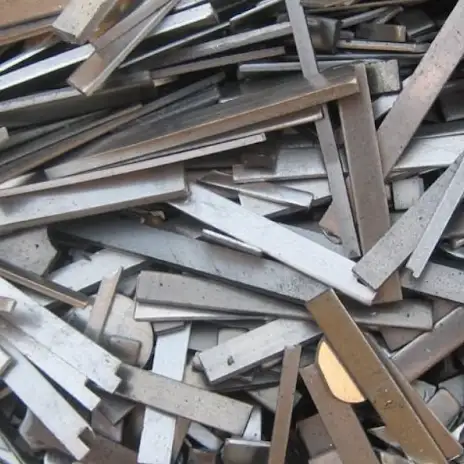As of mid-2025, recycled Inconel 625 scrap typically trades in the range of about $5–$20 per pound for non-processed mixed scrap and $20–$35 per pound for higher-quality, segregated, mill-grade swarf or certified clean turnings — final prices depend strongly on alloy purity, form (chip, turnings, ingot, mill scrap), available certifications, regional demand and the nickel commodity price (LME). For precise commercial quotes, large lots and certified material command premiums; MWAlloys can supply factory pricing and custom recycling / buy-back services for exporters and OEMs.
What is Inconel 625?
Inconel 625 (UNS N06625) is a chromium-nickel-molybdenum-niobium (columbium) nickel-base superalloy renowned for high tensile strength, exceptional corrosion resistance and stability at elevated temperatures. Typical composition includes Ni ≈ 58% (min), Cr ~20–23%, Mo ~8–10%, Nb+Ta ~3.15–4.15% plus small amounts of Fe, Co, Mn, Si and C. These alloying elements — especially nickel, molybdenum and niobium — are the main reasons Inconel 625 has high scrap value relative to common stainless steels.
How scrap markets value Inconel 625?
Scrap buyers classify material by form, alloy purity and documentation:
-
Mill / certified clean scrap (e.g., cut plate, certified off-cuts with test reports) — highest price.
-
Turnings and swarf (oil-contaminated vs cleaned) — mid to high price depending on cleanliness and contamination.
-
Mixed superalloy scrap or contaminated pieces — lower price and often priced by element recovery.
-
Castings or heavily oxidized parts — price discounted for processing complexity.
Buyers also apply surcharges/adjusters based on alloy family (a recognized "alloy surcharge" is applied by some mill suppliers), and many refined recyclers reference nickel LME levels when settling large transactions.
Past five-year market price table (typical scrap price per lb)
Note: scrap markets are fragmented; prices below are consolidated, conservative ranges derived from trade reports, public scrap indices and dealer quotations. Use for modelling, not contract settlement.
| Year | Typical range (USD / lb) — mill-grade / certified | Typical range (USD / lb) — mixed/turnings | Market drivers that year |
|---|---|---|---|
| 2019 | $12 – $22 | $4 – $10 | Stable nickel market, steady aerospace/O&G demand. |
| 2020 | $10 – $20 | $3 – $9 | COVID disruption reduced industrial demand; supply bottlenecks for some alloys. |
| 2021 | $18 – $30 | $6 – $14 | Post-pandemic rebound; nickel and superalloy demand rose. |
| 2022 | $22 – $36 | $8 – $16 | Volatility from raw material inflation and logistics; nickel spiked mid-year. |
| 2023 | $18 – $32 | $6 – $14 | Cooling commodity prices, some O&G capex slowdown; inventories cleared. |
| 2024 | $15 – $30 | $5 – $15 | Mixed regional recovery; nickel production shifts (Indonesia etc.) impacted supply balances. |
(Data sources and indices include ScrapIndex, regional scrap dealers, and LME/Nickel market reporting — aggregated to form a practical pricing ladder).

Global price snapshot — representative regional quotations 2025
Estimated ranges for 2025 (typical spot/wholesale levels for recyclable Inconel 625, per lb in USD). Actual quotes vary by lot size, spec and certificates.
| Region | Clean mill scrap (USD / lb) | Turnings / swarf (USD / lb) | Notes |
|---|---|---|---|
| United States | $22 – $35 | $8 – $18 | Strong refinery capacity; exporters face freight and environmental compliance costs. |
| Europe (EU) | $25 – $38 | $10 – $22 | Proximity to aerospace/chemical demand lifts premiums. |
| China | $18 – $30 | $6 – $16 | Domestic demand remains solid; import controls and processing costs alter netbacks. |
| India / South Asia | $15 – $28 | $5 – $14 | Growing buyer base for remelting and component re-use. |
| Middle East / North Africa | $17 – $32 | $6 – $15 | O&G maintenance cycles drive intermittent demand. |
(The grid aggregates dealer quotes, market notices and regional mills. Large certified lots can exceed the upper band; contaminated or mixed scrap will be below the lower band.)
What drives the price?
-
Nickel commodity price (LME / cash premiums). Nickel is the dominant value component in Inconel 625; swings in LME cash or 3-month nickel feed through to alloy scrap.
-
Molybdenum and niobium content: These refractory elements add value and are recovered by specialty recyclers; markets for these metals affect scrap bids.
-
Form & contamination: Swarf contaminated with oils, coolants, or ferrous inclusions reduces furnace yield and penalizes price. Clean, segregated swarf fetches better rates.
-
Certification & traceability: Certified mill offcuts with test reports (chemical & mechanical) are priced closer to mill product salvage value.
-
Regional smelting/remelting capacity and logistics: Proximity to remelters and trade barriers (duties, import inspections) alter netbacks.
-
End-market demand (aerospace, petrochem): Maintenance cycles, refit seasons and capex plans drive offtake for clean alloy scrap.
Typical recycling & recovery workflow
-
Segregation at source: Keep Inconel 625 separate from stainless and other nickel alloys; batch by form.
-
Documentation: Mill certificates, heat-numbers and material test reports greatly increase offers.
-
Drying & cleaning: Minimizing oil/grease on turnings raises furnace yield and price.
-
Assay & weighing: Buyers perform a metal assay; payment terms usually adjusted for assay and moisture.
-
Remelting/refining: Specialist remelters reclaim nickel, molybdenum and niobium; recovery rates and refining costs determine net value.
Standards & technical requirements that affect pricing
Common production and specification standards for Inconel 625 mill products (relevant when delivering certified scrap or offcuts): ASTM B443 (plates/sheets), ASTM B444 (tube/pipe), ASTM B446 (rod/bar), ASME/AMS specs. Meeting or referencing these standards in documentation provides buyers assurance and often commands premiums.
Five- to ten-year outlook
Base case (moderate growth, 2025–2030): Slow but steady demand from petrochemical turnarounds and increasing aerospace production as older fleets are upgraded — nickel market normalizes with incremental green-nickel flows (battery/nickel demand lower impact for high-grade superalloys). Expect modest annual price growth (CAGR 2–5%) for certified scrap.
Upside (heavy industrial recovery & constrained supply): If global manufacturing and civil aero accelerate together with supply disruptions at major nickel mines, prices could spike; premiums for certified, large-lot Inconel scrap may rise 20–50% in tight markets.
Downside (oversupply / substitution): If remelting capacity expands faster than demand or OEMs substitute lower-cost alloys for certain uses, premiums compress and scrap prices could fall toward the lower bands. Recycling technology improvements that lower refining cost would also push buyer offers down.
Implication for suppliers: Lock in offtake agreements with reputable remelters; prioritize certification and pre-cleaning to capture upper bands.
FAQs
-
Q: What is the single biggest factor that determines Inconel 625 scrap price?
A: The market price of nickel (LME) because nickel composes the largest value share; molybdenum and niobium also matter. -
Q: How much does Inconel 625 scrap pay per pound in 2025?
A: Typical clean mill scrap: $20–$35/lb; mixed turnings: $5–$18/lb depending on region and cleanliness. -
Q: Will contaminated turnings be rejected?
A: Not usually rejected but heavily penalized. Clean or pretreated material achieves much better prices. -
Q: Are mill certificates required to get top price?
A: Yes — certified material with chemical & heat traceability typically commands a premium. -
Q: Can I sell Inconel 625 scrap internationally?
A: Yes — but prepare export documentation, quality certificates and check local import rules; freight & duties affect netbacks. -
Q: How do buyers assay the material?
A: Spectrographic OES/XRF or wet chemical assays are standard; buyers may adjust price after independent assay. -
Q: Is alloy 625 the same as Nickel 625?
A: Yes — “Alloy 625,” “Inconel 625” and “UNS N06625” all refer to the same nickel-base superalloy family. -
Q: What is recovery rate for turning/swarf?
A: Recovery depends on contamination; typical metal recovery for clean turnings is high (70–90% for nickel value), but cleaning costs reduce gross return. -
Q: Do specialty alloy surcharges apply?
A: Yes — many mills and suppliers publish monthly alloy surcharge tables which influence mill product pricing and the scrap aftermarket. -
Q: How should I prepare material to get a firm quote?
A: Segregate by alloy/heat, provide mill certificates, clean material, and offer a representative sample for assay; solicit multiple bids.

